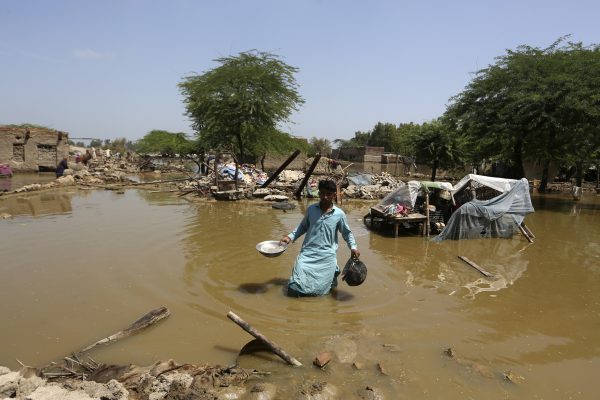“Manmade Disaster”: Addressing the Root Causes of Pakistan’s Hydro-Climatic Catastrophes
Executive Summary
Heavy rainfall and flood disasters are recurring threats across Pakistan, yet labeling them as solely climate-induced oversimplifies deeper systemic issues. In his editorial, Naseer Memon attributes the scale of recent disasters—particularly in Gilgit–Baltistan, Swat, and southern Punjab—to human-induced factors such as rampant deforestation, obstructed waterways, encroachments, and climate-insensitive infrastructure. These factors have amplified natural hazards, turning them into “manmade disasters.” It is imperative to establish integrated ecosystem management, enforce land-use regulations, and institutionalize a climate-conscious development framework to avert future catastrophes.
1. Introduction
Pakistan’s monsoon and mountainous geography make hydro-climatic events inevitable. However, unchecked human interference—deforestation, infrastructure misalignment, urban encroachments—has compounded the damage. Memon warns that media’s sensationalism around “climate change” and “cloudburst” narratives distracts from addressing these underlying causes.Dawn
2. Analytical Overview: Human-Amplified Hazards
| Factor | Description |
|---|---|
| Deforestation | Illegal logging in Swat and GB has stripped mountains of protective cover; forest loss in GB exceeds 1,700 km² over two decades.Dawn |
| Waterway Obstructions | Encroachments on floodplains and riverbeds (e.g., Sutlej, Ravi, Chenab) impede natural outflows, worsening flood impact.Dawn |
| Climate-Insensitive Infrastructure | Settlements and infrastructure in high-risk zones, such as katcha areas, remain vulnerable to floods.DawnThe News International |
3. Case Illustrations
-
Swat Valley & GB: High-altitude boulder-strewn flows intensified by deforested slopes. Swat’s logging, especially during 2007–09, removed forest buffers that previously mitigated flash floods.Dawn
-
Neelum Valley (Kashmir): Deforested hills contributed to destructive floods impacting infrastructure like dams.Dawn
-
Southern Punjab & Sindh: Encroachments on river floodplains—formerly dry beds—led to catastrophic urban flooding (e.g. Sialkot) when rivers breached after decades.Dawn
4. Structural Gaps in Disaster Management
Naseer Memon underscores that disasters are less the result of abnormal weather and more of prolonged misgovernance.Dawn Supportive analysis further reveals:
-
Institutional Fragility: District Disaster Management Authorities (DDMAs) lack dedicated personnel, training, and capacity to respond swiftly.The News International
-
Reactive Approach: Emergency responses are often delayed, inefficient, and lack strategic planning.The News International
5. Policy Recommendations
-
Environmental Restoration
-
Launch large-scale afforestation in mountainous catchments (Swat, GB).
-
Curb illegal logging with stringent enforcement and community-based forest management.
-
-
Waterway Rehabilitation
-
Remove encroachments from floodplains and implement hydrological zoning.
-
Preserve dry riverbeds as natural buffers.
-
-
Climate-Resilient Planning
-
Avoid infrastructure development in flood-prone zones.
-
Use climate-sensitive designs in housing, roads, and tourism facilities.
-
-
Strengthening Disaster Institutions
-
Empower DDMAs with resources and technical capacity for early warning and response.
-
Create resilient local disaster protocols integrated with community training.
-
-
Ecosystem Audits and Governance
-
Conduct climate-ecosystem impact audits across slope-to-coast regions.
-
Establish oversight to ensure infrastructure investments are climate-proof.
-
-
Public Awareness & Media Reform
-
Promote media literacy to shift narrative from blame to informed prevention.
-
Encourage community engagement in environmental stewardship.
-
6. Vocabulary & Key Concepts
| Term | Definition |
|---|---|
| Manmade Disaster | Disasters intensified by human activity (e.g., deforestation, encroachment). |
| Hydro-Climatic Events | Weather events involving water—rain, floods, glacial bursts. |
| Ecosystem Integrity Audit | Comprehensive review of infrastructure and land-use for environmental risk. |
| DDMA | District-level Disaster Management Authority responsible for local response. |
| Climate-Insensitive Infrastructure | Structures built without resilience against weather extremes. |
7. Conclusion
Naseer Memon’s editorial is a clarion call to reframe flood disasters as largely predictable and preventable outcomes of human neglect. Sustainable disaster resilience in Pakistan demands reversing environmental degradation, reforming land-use governance, and building institutional frameworks that are proactive rather than reactive. Only then can natural hazards be transformed from calamity to manageable risk.


